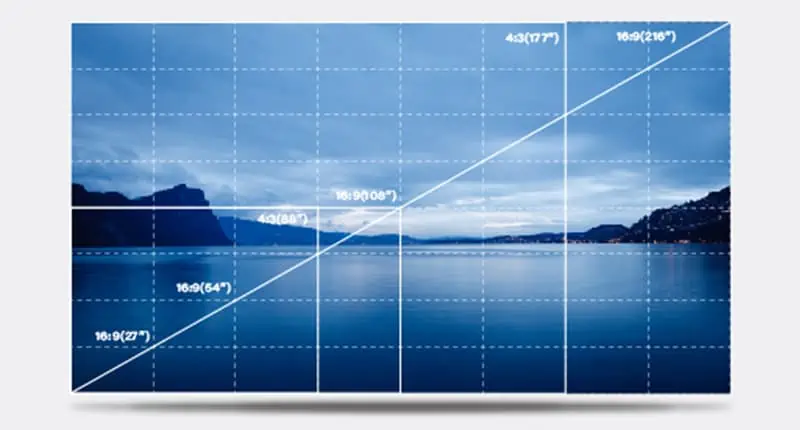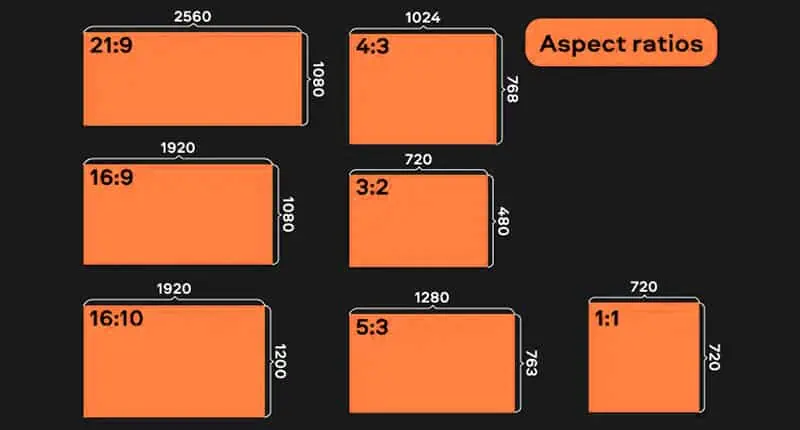When it comes to choosing LED screens, a fundamental parameter that plays a crucial role in determining the overall viewer experience is the ‘Aspect Ratio’. Whether it’s an indoor conference room, a home theater setup, or an outdoor digital billboard, the aspect ratio can significantly impact the visual presentation and the audience’s perception.
What is Aspect Ratio?
In simple terms, the aspect ratio of a screen refers to the proportional relationship between its width and height. For instance, an aspect ratio of 16:9 means that for every 16 units of width, there are 9 units of height.
The Importance of Aspect Ratio in LED Screens
Understanding the aspect ratio is critical when working with LED screens because it directly influences how the content will be displayed. A mismatched ratio could stretch or shrink your content, insert unwanted black bars on the sides, or worse, make you lose some valuable information due to cropping. Depending on the application, choosing the right aspect ratio can make a world of difference to the viewing experience.
16:9 Aspect Ratio
The 16:9 aspect ratio is also known as ‘widescreen’. It’s widely adopted in modern devices and digital platforms, from your HDTVs and computer monitors to your smartphones and online video streaming services.
Advantages of 16:9 Aspect Ratio
When you opt for a 16:9 LED screen, you’re essentially getting a wider field of view. This wideness is ideal for displaying high-definition content, making it the de-facto choice for applications like films, video games, and web content. Because of its popularity, most of the content produced today is created with the 16:9 ratio in mind, which means a 16:9 screen displays the content as the creator intended, without any distortions or alterations.

Specific Use Cases of 16:9 Aspect Ratio
Imagine you’re setting up a home theater system or a digital signboard where you want to deliver an immersive viewing experience. Here, a 16:9 LED screen works perfectly, delivering panoramic views that capture the audience’s attention.
4:3 Aspect Ratio
Before the 16:9 ratio became prevalent, the 4:3 aspect ratio was the standard for many years. Although it’s not as widely used today, the 4:3 ratio still has its merits.
Advantages of 4:3 Aspect Ratio
The 4:3 aspect ratio may not offer the cinematic and immersive feel of a 16:9 screen, but it does have its strengths. It gives more vertical space, making it a preferred choice for applications where vertical detail is crucial or when the content is more static and text-heavy.
Specific Use Cases of 4:3 Aspect Ratio
Consider you’re installing a security system with multiple CCTV cameras. A 4:3 screen can display more vertical area, making it easier to monitor and spot critical details. Similarly, in an educational setting where presentations are more text-based, a 4:3 screen can be more effective.
16:9 vs 4:3: Which is Better?
Picking the right aspect ratio for your LED screen isn’t a one-size-fits-all scenario. The “better” choice varies depending on the specific use case and environment.
Learn about other aspect ratios.

21:9 Aspect Ratio
Often found in cinemas, the 21:9 aspect ratio is perfect for an immersive, cinematic experience. The wider format makes it ideal for watching films and panoramic views.
16:10 Aspect Ratio
The 16:10 aspect ratio is a common choice for computer monitors, providing additional vertical space that’s perfect for productivity tasks like document editing or web browsing.
5:3 Aspect Ratio
Although not as common, the 5:3 aspect ratio is used in certain mobile devices and digital cameras. This ratio provides a balance between width and height, suitable for both landscape and portrait modes.
3:2 Aspect Ratio
The 3:2 aspect ratio is popular among photographers. It closely matches the shape of photos, providing a natural and familiar viewing experience.
1:1 Aspect Ratio
The 1:1 aspect ratio is equal in width and height, creating a perfect square. This ratio is commonly used in social media platforms like Instagram.
Choosing the Best Aspect Ratio for Indoor LED Screens
When selecting an aspect ratio for indoor LED screens, consider your content and space. A 16:9 ratio is often ideal due to its versatility and compatibility with most media content. However, for unique spaces or specific content, other aspect ratios may provide a better visual impact.
Selecting the Ideal Aspect Ratio for Outdoor LED Screens
For outdoor scenarios, such as digital billboards or information boards, the choice between 16:9 and 4:3 depends on the type of content and the typical viewing distances. If your content is more panoramic and viewed from a distance, 16:9 could be more effective. Conversely, if your display is more information-heavy and viewed from closer distances, a 4:3 screen could be more suitable.
Conclusion
Ultimately, there’s no “best” aspect ratio that suits every situation. The perfect aspect ratio for your LED screen depends on your content, application, and viewer’s perspective. By understanding these factors, you can choose the right aspect ratio that delivers an optimal viewing experience.
FAQs
1. Why do LED screens have different aspect ratios?
Different aspect ratios provide various viewing experiences and serve different purposes. The aspect ratio you choose should depend on the content you’re displaying and the intended viewing context.
2. How does aspect ratio affect the viewing experience?
The aspect ratio can influence how content fits on the screen and how viewers perceive it. A wrong aspect ratio can lead to image distortion, such as stretching or squishing.
3. What is the standard aspect ratio for most televisions and computer monitors?
The standard aspect ratio for most televisions and computer monitors today is 16:9.
4. Is a wider aspect ratio always better?
Not necessarily. A wider aspect ratio can provide a more immersive viewing experience, but it may not be suitable for all types of content or viewing conditions.
